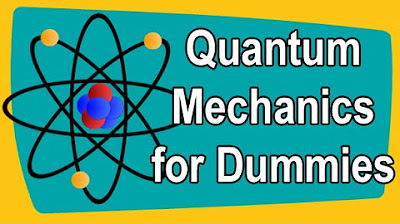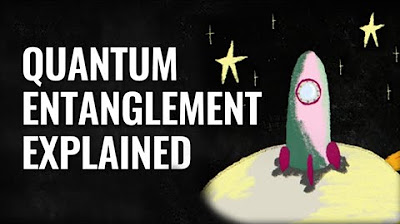Quantum Entanglement: Explained in REALLY SIMPLE Words
TLDRThe video script explores the fascinating world of quantum mechanics, contrasting it with classical mechanics which governs larger objects. It introduces the concept of quantum entanglement, where particles like electrons become linked, and the state of one instantaneously influences the other, regardless of distance. This phenomenon is illustrated through the famous Schrödinger's Cat thought experiment, highlighting the idea of superposition where particles exist in multiple states simultaneously until measured. The script also touches on the practical applications of quantum entanglement, such as in creating ultra-precise clocks, enhancing GPS and telecommunications, securing information through quantum cryptography, and improving microscopes. It concludes with the potential of quantum teleportation, which involves the transfer of information rather than matter, and the ongoing quest to harness quantum mechanics for revolutionary technological advancements.
Takeaways
- 🌟 Quantum entanglement is a phenomenon where particles like electrons become linked and the state of one instantly influences the state of another, no matter the distance between them.
- ⚙️ Classical Mechanics governs the motion of large objects, but Quantum Mechanics is needed to explain the behavior of extremely small particles like electrons and photons.
- 📏 Quantum mechanics operates in a realm where the size of particles is so small that a needle tip could hold billions of electrons.
- 🆔 Electrons are identified by four quantum numbers: Principal quantum number, Orbital angular momentum quantum number, Magnetic quantum number, and Electron spin quantum number.
- 🔄 The concept of 'spin' in electrons does not refer to physical rotation but to the intrinsic angular momentum and magnetic orientation of the particle.
- 🤔 Superposition is a quantum state where particles like electrons exist in multiple states simultaneously, such as both 'spin up' and 'spin down'.
- 🐱 Schrödinger's Cat is a thought experiment that illustrates superposition by proposing a scenario where a cat in a box is both alive and dead until observed.
- 🌐 Quantum entanglement has practical applications, such as in the development of highly precise atomic clocks, which could enhance GPS and telecommunications technology.
- 🔒 Quantum cryptography uses principles of quantum mechanics to create secure communication channels, where any attempt at eavesdropping can be detected.
- 🧬 Entanglement-enhanced microscopes can gather more information by using entangled photons, improving the resolution and quality of microscopic imaging.
- ✨ Quantum teleportation is possible for information, not matter, and relies on the entanglement of particles to transmit quantum states over distances.
- 🧠 Understanding quantum mechanics is challenging and counterintuitive, as noted by Richard Feynman, suggesting it's a field that defies conventional logic.
Q & A
What is the basic concept of Quantum Entanglement?
-Quantum Entanglement is a phenomenon in which two or more particles become linked in such a way that the state of one particle instantly influences the state of the other, no matter how far apart they are. It's often described as if the particles are 'entangled' in a certain way, sharing a connection that transcends classical physics.
How does Quantum Mechanics differ from Classical Mechanics?
-Classical Mechanics deals with the motion of macroscopic bodies according to Newton's laws, while Quantum Mechanics is the study of the behavior of particles at the atomic and subatomic level. Quantum Mechanics reveals that these tiny particles do not follow the same laws as larger objects; instead, they exhibit strange and counterintuitive properties, such as superposition and entanglement.
What is the scale of an electron in comparison to a needle tip?
-An electron is incredibly small, with the tip of a needle being so large that it could fit billions of electrons. This comparison illustrates the vast difference in scale between everyday objects and the subatomic particles that quantum mechanics describes.
How many levels of identification does an electron have?
-An electron has four levels of identification, which are described by four quantum numbers: the Principal quantum number, the Orbital angular momentum quantum number, the Magnetic quantum number, and the Electron spin quantum number.
What is the concept of 'superposition' in quantum mechanics?
-Superposition is a fundamental principle of quantum mechanics where a particle can exist in multiple states simultaneously. For example, an electron can be in a state of both 'spin up' and 'spin down' until it is measured, at which point the wave function 'collapses' to a single state.
What is Schrödinger's Cat thought experiment?
-Schrödinger's Cat is a thought experiment that illustrates the concept of superposition. It involves a cat in a box with a radioactive substance, a vial of poison, and a Geiger counter. If the substance decays, the Geiger counter triggers the release of the poison, killing the cat. Since the decay is random, the cat is considered to be both alive and dead until the box is opened and the cat is observed.
How does quantum entanglement relate to the spin states of electrons?
-When two electrons are entangled, their spin states become linked. This means that if one electron is measured to have an 'up spin', the other electron, no matter the distance, will instantly be in the 'down spin' state. This correlation occurs instantaneously, which is a key aspect of quantum entanglement.
Why is quantum entanglement considered 'spooky action at a distance'?
-The term 'spooky action at a distance' was coined by Albert Einstein to describe the phenomenon where entangled particles affect each other instantaneously over any distance, which seemed to challenge the local realism of classical physics and the speed of light as the ultimate speed limit.
How can entangled atomic systems be used to improve the precision of clocks?
-Entangled atomic systems can be used to create highly precise quantum-logic clocks. Since entangled particles are not affected by local differences, they can measure the passage of time as a single unit. Adding more entangled atoms to the system increases its precision, potentially leading to a worldwide network of synchronized clocks that could greatly enhance GPS and telecommunication technologies.
What is quantum cryptography and how does it use entanglement?
-Quantum cryptography is a method of secure communication that uses the principles of quantum mechanics to encrypt messages. It often involves the use of entangled photons, where the quantum state of one photon is linked to the state of another. Any attempt to intercept or measure the quantum state of the photons would be immediately apparent, making the system highly secure.
How does quantum entanglement enhance the capabilities of a microscope?
-Entanglement-enhanced microscopes use entangled photons to gather more information than traditional microscopes. By measuring one entangled photon, information about its partner photon is also obtained, allowing for a greater resolution and the ability to see smaller details.
What is the concept of quantum teleportation and how does it differ from popular culture depictions?
-Quantum teleportation is the process of transferring quantum information from one location to another, without physically transporting the particle itself. It involves the transfer of the quantum state of a particle to another particle at a distant location, using entanglement and classical communication. This is different from the fictional teleportation seen in movies, which typically involves the physical transport of matter.
Outlines
🍔 Quantum Entanglement Explained
The first paragraph uses the analogy of a hot dog and a hamburger in similar boxes to introduce the concept of quantum entanglement. It explains that in quantum mechanics, particles like photons and those within an atom behave differently from larger objects that follow classical mechanics. Quantum mechanics deals with the very small, and electrons, being incredibly tiny, are described by quantum numbers that give them unique identities. The paragraph focuses on the electron spin quantum number, which can be in a superposition of both 'spin up' and 'spin down' states until measured. The famous thought experiment of Schrödinger's Cat is used to illustrate superposition, where the cat is considered both alive and dead until the box is opened, similar to an electron's spin state before measurement.
🌌 Quantum Entanglement's Phenomena and Applications
The second paragraph delves into the phenomenon of quantum entanglement, where two or more particles become linked and the state of one instantaneously influences the state of the other, regardless of distance. This is demonstrated by the example of entangled electrons having opposite spins. Albert Einstein referred to this as 'spooky action at a distance'. The paragraph then explores practical applications of quantum entanglement, including the creation of highly precise clocks, advancements in GPS and telecommunications, and the field of quantum cryptography which uses entangled photons to create secure communication channels. It also touches on the use of entangled photons in microscopy to gather more information and briefly mentions the concept of quantum teleportation, which involves the transfer of information rather than physical matter.
Mindmap
Keywords
💡Quantum Entanglement
💡Classical Mechanics
💡Quantum Mechanics
💡Electron
💡Quantum Numbers
💡Superposition
💡Wave Function Collapse
💡Entanglement-enhanced Microscope
💡Quantum Teleportation
💡Quantum Cryptography
💡Quantum Logic Clock
Highlights
Quantum entanglement is based on the idea that once you open one box and see a burger, you immediately know the other box has the hot dog.
Quantum mechanics takes over and things get extremely weird when dealing with objects that are really, really small.
Electrons are incredibly small - the tip of a needle could fit billions of electrons.
An electron has 4 levels of identification consisting of 4 quantum numbers.
The electron spin quantum number determines if an electron has a positive (spin up) or negative (spin down) spin.
An electron can exist in a state of superposition, having both a negative and positive spin.
Schrodinger's Cat is a famous thought experiment illustrating superposition - the cat is both alive and dead until the box is opened.
When a pair of electrons are entangled, they can only have opposite spins.
If one entangled electron is measured to have up spin, the other one instantly becomes down spin, regardless of distance.
Albert Einstein called this 'spooky action at a distance' where information travels faster than the speed of light.
Entangled atomic systems could be used to create extremely precise clocks.
Adding more entangled atoms to a clock makes it even more precise.
Entangled clocks could form a worldwide network for precise timekeeping, improving GPS and telecommunications.
Quantum cryptography uses entangled photons to create ultra-secure communication networks.
Entangled photons can be used to create tamper-proof systems, like a secure voting system used in Switzerland.
Entanglement-enhanced microscopes use entangled photons to gather more information.
Quantum teleportation is possible for subatomic particles by teleporting information, not matter.
Harnessing quantum entanglement has the potential to revolutionize every aspect of our existence.
Quantum mechanics is a strange branch of science that doesn't make sense in the real world, as famously said by Richard Feynman.
Transcripts
Browse More Related Video

What can Schrödinger's cat teach us about quantum mechanics? - Josh Samani

Quantum Mechanics for Dummies

Quantum Computing Expert Explains One Concept in 5 Levels of Difficulty | WIRED

Quantum Entanglement: Spooky Action at a Distance

Lecture 7 | Quantum Entanglements, Part 1 (Stanford)

Quantum 101 Episode 5: Quantum Entanglement Explained
5.0 / 5 (0 votes)
Thanks for rating: